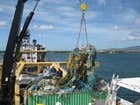This week, Commerce Secretary Gary Locke, Under Secretary for Oceans and Atmosphere and National Oceanic and Atmospheric Administration (NOAA) Administrator Dr. Jane Lubchenco and other dignitaries will celebrate Earth Week at eight of the 50 coastal and Great Lakes habitat restoration projects funded through the American Recovery and Reinvestment Act of 2009.
“Recovery Act projects have put Americans back to work restoring coastal habitats, which are critical to the recovery and sustainability of the U.S. economy,” Locke said. “This administration remains committed to providing our coastal communities with the necessary tools to compete globally, create blue and green jobs and restore fisheries and economic vitality to coastal communities.”
“The 40th Earth Day is a time to renew our commitment to the environment,” said Lubchenco, who will travel to projects restoring wetlands on Muskegon Lake in Michigan and coral reefs in the Florida Keys. “These projects are about recovery-- recovering habitat, recovering the economy and recovering our connection to the environment.”
Coastal areas generate more than 28 million jobs in the United States. Commercial and recreational fishing employs 1.5 million people and contributes $111 billion to the nation’s economy.
These coastal and Great Lakes projects are supporting blue and green jobs for Americans by improving habitat for fish, mammals and other wildlife by restoring wetlands and coral reefs, building oyster reefs, taking down obsolete dams to open fish passage and removing derelict fishing gear that clutters coastal waters.
Habitat restoration can lead to long term improvements in water quality, commercial and recreational fishing, tourism and greater resiliency to storms, flooding and the effects of climate change, NOAA said.
Events will take place this week at the following restoration projects:
• April 19: Coastal Carolina Restoration (Cape Hatteras, N.C.);
• April 21: Removal of Derelict Fishing Gear in Puget Sound (Seattle);
• April 22: Muskegon Lake Restoration (Muskegon, Mich.);
• April 22: Grande Isle Shoreline Restoration (Grande Isle, La.);
• April 22: Maunalua Bay Reef Restoration (Maunalua Bay, Hawaii);
• April 22: Lincoln Park Wetland Restoration (Jersey City, N.J.); and
• April 23: Threatened Coral Recovery and Restoration (Florida Keys).
Locke announced last summer 50 habitat restoration projects that will restore damaged wetlands, shellfish beds, coral reefs and reopen fish passages that boost the health and resiliency of the nation’s coastal and Great Lakes communities.Under the American Recovery and Reinvestment Act of 2009, the Department’s NOAA was provided $167 million for marine and coastal habitat restoration.
When all the planned projects are complete, 8,900 acres of habitat will be restored, and fish will gain access to 700 stream miles that had been blocked by obsolete and unsafe dams. The projects also will remove more than 850 metric tons of abandoned fishing gear and other marine trash, rebuild oyster and other shellfish habitat and reduce threats to 11,750 acres of coral reefs.
Source: NOAA


